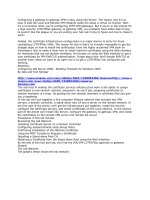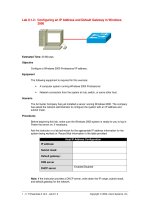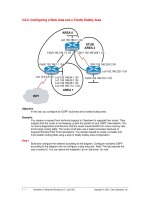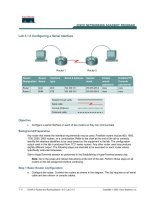Configuring a Stub Area and a Totally Stubby Area
Bạn đang xem bản rút gọn của tài liệu. Xem và tải ngay bản đầy đủ của tài liệu tại đây (31.88 KB, 5 trang )
1 - 1 Semester 5: Advanced Routing v2.0 - Lab 5.8.2 Copyright 2001, Cisco Systems, Inc.
5.8.2: Configuring a Stub Area and a Totally Stubby Area
AREA 0
STUB
AREA 2
AREA 1
Lo0 192.168.3.1 /24
S0/1 192.168.208.1 /30Fa0/0 192.168.1.3 /24
Lo0 192.168.64.1 /24
Lo1 192.168.80.1 /24
Lo2 192.168.96.1 /24
Lo3 192.168.112.1 /24
Lo0 192.168.220.1 /24
S0/0 192.168.224.2 /24
ISP1
SanJose3
SanJose1 Capetown
Fa0/0 192.168.1.1 /24
Lo5 10.0.0.6 /30
Fa0/0 192.168.216.1 /24
Objective
In this lab, you configure an OSPF stub area and a totally stubby area.
Scenario
You receive a request from technical support in Capetown to upgrade their router. They
suspect that the router is not keeping up with the growth of your OSPF internetwork. You
run some diagnostics and discover that the router could benefit from more memory due
to the large routing table. The router could also use a faster processor because of
frequent Shortest Path First calculations. You decide instead to create a smaller and
more stable routing table using a stub or totally stubby area configuration.
Step 1
Build and configure the network according to the diagram. Configure multiarea OSPF
according to the diagram (do not configure a stub area yet). Note: This lab requires the
use of subnet 0. You can ignore the loopback Lo5 on SanJose1 for now.
2 - 2 Semester 5: Advanced Routing v2.0 - Lab 5.8.2 Copyright 2001, Cisco Systems, Inc.
Configure each router with the loopback address as indicated in the diagram. Be sure to
configure SanJose1 with additional loopbacks (Lo0, Lo1, Lo2, Lo3). These loopback
interfaces will simulate the serial links to local San Jose sites: Westasman, Baypointe,
Vista, and Eastasman.
Capetown#show ip route
Gateway of last resort is not set
192.168.208.0/30 is subnetted, 1 subnets
C 192.168.208.0 is directly connected, Serial0/0
192.168.64.0/32 is subnetted, 1 subnets
O IA 192.168.64.1 [110/66] via 192.168.208.1, 00:20:04,
Serial0/0
C 192.168.216.0/24 is directly connected, FastEthernet0/0
192.168.80.0/32 is subnetted, 1 subnets
O IA 192.168.80.1 [110/66] via 192.168.208.1, 00:20:04,
Serial0/0
192.168.96.0/32 is subnetted, 1 subnets
O IA 192.168.96.1 [110/66] via 192.168.208.1, 00:20:04,
Serial0/0
192.168.112.0/32 is subnetted, 1 subnets
O IA 192.168.112.1 [110/66] via 192.168.208.1, 00:20:05,
Serial0/0
C 192.168.220.0/24 is directly connected, Loopback0
O IA 192.168.1.0/24 [110/65] via 192.168.208.1, 00:20:05,
Serial0/0
192.168.3.0/32 is subnetted, 1 subnets
O IA 192.168.3.1 [110/65] via 192.168.208.1, 00:20:07,
Serial0/0
Use ping and show ip route to test connectivity between all interfaces. Each router
should be able to ping all network interfaces.
Step 2
Configure SanJose1 to redistribute an external route into the OSPF domain:
SanJose1(config)#ip route 10.0.0.0 255.0.0.0 null0
SanJose1(config)#router ospf 1
SanJose1(config-router)#redistribute static
Also, create a loopback interface to simulate the serial interface connecting to ISP1:
SanJose1(config)#interface lo5
SanJose1(config-if)#ip address 10.0.0.6 255.255.255.252
Check the routing tables of all three routers; they should be complete.
Capetown#show ip route
Gateway of last resort is not set
192.168.208.0/30 is subnetted, 1 subnets
C 192.168.208.0 is directly connected, Serial0/0
192.168.64.0/32 is subnetted, 1 subnets
O IA 192.168.64.1 [110/66] via 192.168.208.1, 00:07:32,
Serial0/0
C 192.168.216.0/24 is directly connected, FastEthernet0/0
192.168.80.0/32 is subnetted, 1 subnets
O IA 192.168.80.1 [110/66] via 192.168.208.1, 00:07:32,
Serial0/0
3 - 3 Semester 5: Advanced Routing v2.0 - Lab 5.8.2 Copyright 2001, Cisco Systems, Inc.
O E2 10.0.0.0/8 [110/20] via 192.168.208.1, 00:00:35, Serial0/0
192.168.96.0/32 is subnetted, 1 subnets
O IA 192.168.96.1 [110/66] via 192.168.208.1, 00:07:32,
Serial0/0
192.168.112.0/32 is subnetted, 1 subnets
O IA 192.168.112.1 [110/66] via 192.168.208.1, 00:07:32,
Serial0/0
C 192.168.220.0/24 is directly connected, Loopback0
O IA 192.168.1.0/24 [110/65] via 192.168.208.1, 00:07:34,
Serial0/0
192.168.3.0/32 is subnetted, 1 subnets
O IA 192.168.3.1 [110/65] via 192.168.208.1, 00:07:34,
Serial0/0
SanJose3 and Capetown should also have a Type 2 external route to 10.0.0.0/8. They
will not have a specific route to the loopback network(10.0.0.4/30). That network has not
explicitly been advertised by any means.
Step 3
Capetown has several interarea (IA) routes and one external (E2) route. In complex
OSPF networks, a large number of external and interarea routes can needlessly weigh
down some routers. Because Capetown is in a stub area, an area with one egress point,
it does not need external routing information, or even interarea summaries. Capetown
just needs a default route to the ABR, SanJose3.
By configuring Area 2 as a stub area, SanJose3 automatically propagates a default route
into Area 2. Use the following commands to configure the stub area:
SanJose3(config)#router ospf 1
SanJose3(config-router)#area 2 stub
You must also configure Capetown:
Capetown(config)#router ospf 1
Capetown(config-router)#area 2 stub
Verify that Area 2 is a stub by issuing the show ip ospf command:
CapeTown#show ip ospf
Routing Process "ospf 1" with ID 192.168.220.1
Supports only single TOS(TOS0) routes
SPF schedule delay 5 secs, Hold time between two SPFs 10 secs
Minimum LSA interval 5 secs. Minimum LSA arrival 1 secs
Number of external LSA 0. Checksum Sum 0x0
Number of DCbitless external LSA 0
Number of DoNotAge external LSA 0
Number of areas in this router is 1. 0 normal 1 stub 0 nssa
External flood list length 0
Area 2
Number of interfaces in this area is 2
It is a stub area
Area has no authentication
SPF algorithm executed 6 times
Area ranges are
Number of LSA 9. Checksum Sum 0x428E6
Number of DCbitless LSA 0
Number of indication LSA 0
Number of DoNotAge LSA 0
Flood list length 0
4 - 4 Semester 5: Advanced Routing v2.0 - Lab 5.8.2 Copyright 2001, Cisco Systems, Inc.
1. According to the output of this command, what type of OSPF area is Area 2?
Now check Capetown’s routing table. Note that a default route (0.0.0.0/0) has been
generated by the stub’s ABR (SanJose3) and now appears in Capetown’s table.
Capetown#show ip route
Gateway of last resort is 192.168.208.1 to network 0.0.0.0
192.168.208.0/30 is subnetted, 1 subnets
C 192.168.208.0 is directly connected, Serial0/0
192.168.64.0/32 is subnetted, 1 subnets
O IA 192.168.64.1 [110/66] via 192.168.208.1, 00:01:01,
Serial0/0
C 192.168.216.0/24 is directly connected, FastEthernet0/0
192.168.80.0/32 is subnetted, 1 subnets
O IA 192.168.80.1 [110/66] via 192.168.208.1, 00:01:01,
Serial0/0
192.168.96.0/32 is subnetted, 1 subnets
O IA 192.168.96.1 [110/66] via 192.168.208.1, 00:01:01,
Serial0/0
192.168.112.0/32 is subnetted, 1 subnets
O IA 192.168.112.1 [110/66] via 192.168.208.1, 00:01:02,
Serial0/0
C 192.168.220.0/24 is directly connected, Loopback0
O IA 192.168.1.0/24 [110/65] via 192.168.208.1, 00:01:02,
Serial0/0
192.168.3.0/32 is subnetted, 1 subnets
O IA 192.168.3.1 [110/65] via 192.168.208.1, 00:01:03,
Serial0/0
O*IA 0.0.0.0/0 [110/65] via 192.168.208.1, 00:01:03, Serial0/0
2. What type of OSPF route is Capetown’s default route?
Recall that interarea (IA) routes point to networks in different areas within the same
OSPF autonomous system.
Because Area 2 is a stub area, all external routes (Type 5 LSAs) have been prevented
from reaching internal routers.
3. Look carefully at Capetown’s routing table. Does it still have a route to 10.0.0.0/8?
All external routes are filtered from stub areas and are replaced with a default route.
Step 4
You decide that stub area configuration is not making a significant-enough impact on
Area 2. Because Capetown can use the default route to its ABR for all nonlocal area
traffic, you decide to filter Type 3 and Type 4 interarea routes from Area 2. To do this,
you must configure Area 2 as a totally stubby area, which is a Cisco proprietary feature.
Use the following commands on SanJose3, the ABR, to configure Area 2 as a totally
stubby area:
SanJose3(config)#router ospf 1
SanJose3(config-router)#no area 2 stub
SanJose3(config-router)#area 2 stub no-summary
5 - 5 Semester 5: Advanced Routing v2.0 - Lab 5.8.2 Copyright 2001, Cisco Systems, Inc.
The no-summary keyword at the ABR keeps interarea routes from entering stub Area 2,
creating a totally stubby area. Only the ABR needs the additional configuration. The role
of Area 2 internal routers has not changed.
Return to Capetown and check its routing table:
Capetown#show ip route
Gateway of last resort is 192.168.208.1 to network 0.0.0.0
192.168.208.0/30 is subnetted, 1 subnets
C 192.168.208.0 is directly connected, Serial0/0
C 192.168.216.0/24 is directly connected, FastEthernet0/0
C 192.168.220.0/24 is directly connected, Loopback0
O*IA 0.0.0.0/0 [110/65] via 192.168.208.1, 00:00:25, Serial0/0
1. What has changed?
2. Does Area 2 still have connectivity to 10.0.0.0/8? Test with ping 10.0.0.6.
Interarea routes have also been replaced by a default route.
Capetown should get a positive response by forwarding ICMP requests to SanJose3 using the
default route 0.0.0.0/0. SanJose3 has a default route to network 10.0.0.0/8, and SanJose1 has a
directly connected route to 10.0.0.4/30 with the loopback interface 10.0.0.6/30.









